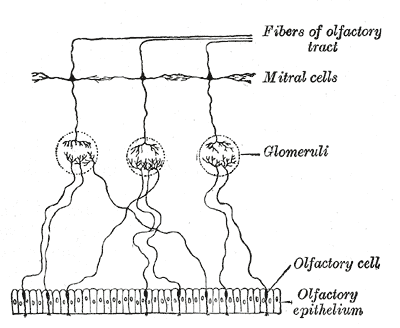[1]
Bruch RC, Kalinoski DL, Kare MR. Biochemistry of vertebrate olfaction and taste. Annual review of nutrition. 1988:8():21-42
[PubMed PMID: 3060165]
[2]
Aso Y, Rubin GM. Dopaminergic neurons write and update memories with cell-type-specific rules. eLife. 2016 Jul 21:5():. pii: e16135. doi: 10.7554/eLife.16135. Epub 2016 Jul 21
[PubMed PMID: 27441388]
[3]
Attems J, Walker L, Jellinger KA. Olfaction and Aging: A Mini-Review. Gerontology. 2015:61(6):485-90. doi: 10.1159/000381619. Epub 2015 May 9
[PubMed PMID: 25968962]
[4]
Scangas GA, Bleier BS. Anosmia: Differential diagnosis, evaluation, and management. American journal of rhinology & allergy. 2017 Jan 1:31(1):3-7. doi: 10.2500/ajra.2017.31.4403. Epub
[PubMed PMID: 28234141]
[5]
Pinching AJ, Powell TP. The neuropil of the glomeruli of the olfactory bulb. Journal of cell science. 1971 Sep:9(2):347-77
[PubMed PMID: 4108057]
[6]
Persaud KC, Marco S, Gutiérrez-Gálvez A, Persaud KC. Engineering Aspects of Olfaction. Neuromorphic Olfaction. 2013:():
[PubMed PMID: 26042329]
[7]
Hatt H. Molecular and cellular basis of human olfaction. Chemistry & biodiversity. 2004 Dec:1(12):1857-69
[PubMed PMID: 17191824]
[8]
Benignus VA, Prah JD. Olfaction: anatomy, physiology and behavior. Environmental health perspectives. 1982 Apr:44():15-21
[PubMed PMID: 7084147]
Level 3 (low-level) evidence
[9]
Sarnat HB, Flores-Sarnat L, Wei XC. Olfactory Development, Part 1: Function, From Fetal Perception to Adult Wine-Tasting. Journal of child neurology. 2017 May:32(6):566-578. doi: 10.1177/0883073817690867. Epub 2017 Feb 19
[PubMed PMID: 28424010]
[10]
Schneider JF, Floemer F. Maturation of the olfactory bulbs: MR imaging findings. AJNR. American journal of neuroradiology. 2009 Jun:30(6):1149-52. doi: 10.3174/ajnr.A1501. Epub 2009 Mar 11
[PubMed PMID: 19279285]
[11]
Shetty S, Kapoor N, John RA, Paul TV. Olfactory Agenesis in Kallmann Syndrome (KS). Journal of clinical and diagnostic research : JCDR. 2015 Apr:9(4):OJ01. doi: 10.7860/JCDR/2015/11761.5777. Epub 2015 Apr 1
[PubMed PMID: 26023587]
[12]
Akers KG, Kushner SA, Leslie AT, Clarke L, van der Kooy D, Lerch JP, Frankland PW. Fetal alcohol exposure leads to abnormal olfactory bulb development and impaired odor discrimination in adult mice. Molecular brain. 2011 Jul 7:4():29. doi: 10.1186/1756-6606-4-29. Epub 2011 Jul 7
[PubMed PMID: 21736737]
[13]
Stoddard DG, Pallanch JF, Hamilton GS. The effect of vibrissae on subjective and objective measures of nasal obstruction. American journal of rhinology & allergy. 2015 Sep-Oct:29(5):373-7. doi: 10.2500/ajra.2015.29.4209. Epub
[PubMed PMID: 26358350]
[15]
Persaud KC, Marco S, Gutiérrez-Gálvez A, Benjaminsson S, Herman P, Lansner A. Performance of a Computational Model of the Mammalian Olfactory System. Neuromorphic Olfaction. 2013:():
[PubMed PMID: 26042330]
[16]
Zarzo M. The sense of smell: molecular basis of odorant recognition. Biological reviews of the Cambridge Philosophical Society. 2007 Aug:82(3):455-79
[PubMed PMID: 17624963]
[17]
Hoover KC. Smell with inspiration: the evolutionary significance of olfaction. American journal of physical anthropology. 2010:143 Suppl 51():63-74. doi: 10.1002/ajpa.21441. Epub
[PubMed PMID: 21086527]
[18]
Pinto JM. Olfaction. Proceedings of the American Thoracic Society. 2011 Mar:8(1):46-52. doi: 10.1513/pats.201005-035RN. Epub
[PubMed PMID: 21364221]
[19]
Brand G. Olfactory/trigeminal interactions in nasal chemoreception. Neuroscience and biobehavioral reviews. 2006:30(7):908-17
[PubMed PMID: 16545453]
[20]
Savage SA, Butler CR, Milton F, Han Y, Zeman AZ. On the nose: Olfactory disturbances in patients with transient epileptic amnesia. Epilepsy & behavior : E&B. 2017 Jan:66():113-119. doi: 10.1016/j.yebeh.2016.09.043. Epub 2016 Dec 28
[PubMed PMID: 28038387]
[21]
Doty RL. The olfactory system and its disorders. Seminars in neurology. 2009 Feb:29(1):74-81. doi: 10.1055/s-0028-1124025. Epub 2009 Feb 12
[PubMed PMID: 19214935]
[22]
Doty RL, Shaman P, Dann M. Development of the University of Pennsylvania Smell Identification Test: a standardized microencapsulated test of olfactory function. Physiology & behavior. 1984 Mar:32(3):489-502
[PubMed PMID: 6463130]
[23]
Kalmey JK, Thewissen JG, Dluzen DE. Age-related size reduction of foramina in the cribriform plate. The Anatomical record. 1998 Jul:251(3):326-9
[PubMed PMID: 9669759]
[24]
Betchen SA, Doty RL. Bilateral detection thresholds in dextrals and sinistrals reflect the more sensitive side of the nose, which is not lateralized. Chemical senses. 1998 Aug:23(4):453-7
[PubMed PMID: 9759533]
[25]
Raviv JR, Kern RC. Chronic sinusitis and olfactory dysfunction. Otolaryngologic clinics of North America. 2004 Dec:37(6):1143-57, v-vi
[PubMed PMID: 15563907]
[26]
Hüttenbrink KB, Hummel T, Berg D, Gasser T, Hähner A. Olfactory dysfunction: common in later life and early warning of neurodegenerative disease. Deutsches Arzteblatt international. 2013 Jan:110(1-2):1-7, e1. doi: 10.3238/arztebl.2013.0001. Epub 2013 Jan 7
[PubMed PMID: 23450985]
[27]
Hawkes C. Olfaction in neurodegenerative disorder. Movement disorders : official journal of the Movement Disorder Society. 2003 Apr:18(4):364-72
[PubMed PMID: 12671941]
[28]
Reiter ER, DiNardo LJ, Costanzo RM. Effects of head injury on olfaction and taste. Otolaryngologic clinics of North America. 2004 Dec:37(6):1167-84
[PubMed PMID: 15563909]
[29]
Jang WY, Jung S, Jung TY, Moon KS, Kim IY. Preservation of olfaction in surgery of olfactory groove meningiomas. Clinical neurology and neurosurgery. 2013 Aug:115(8):1288-92. doi: 10.1016/j.clineuro.2012.12.004. Epub 2013 Jan 10
[PubMed PMID: 23312758]
[30]
Kiparizoska S,Ikuta T, Disrupted Olfactory Integration in Schizophrenia: Functional Connectivity Study. The international journal of neuropsychopharmacology. 2017 Sep 1;
[PubMed PMID: 28582529]
[31]
Heinrichs L. Linking olfaction with nausea and vomiting of pregnancy, recurrent abortion, hyperemesis gravidarum, and migraine headache. American journal of obstetrics and gynecology. 2002 May:186(5 Suppl Understanding):S215-9
[PubMed PMID: 12011889]
[32]
Cameron EL. Pregnancy and olfaction: a review. Frontiers in psychology. 2014:5():67. doi: 10.3389/fpsyg.2014.00067. Epub 2014 Feb 6
[PubMed PMID: 24567726]

